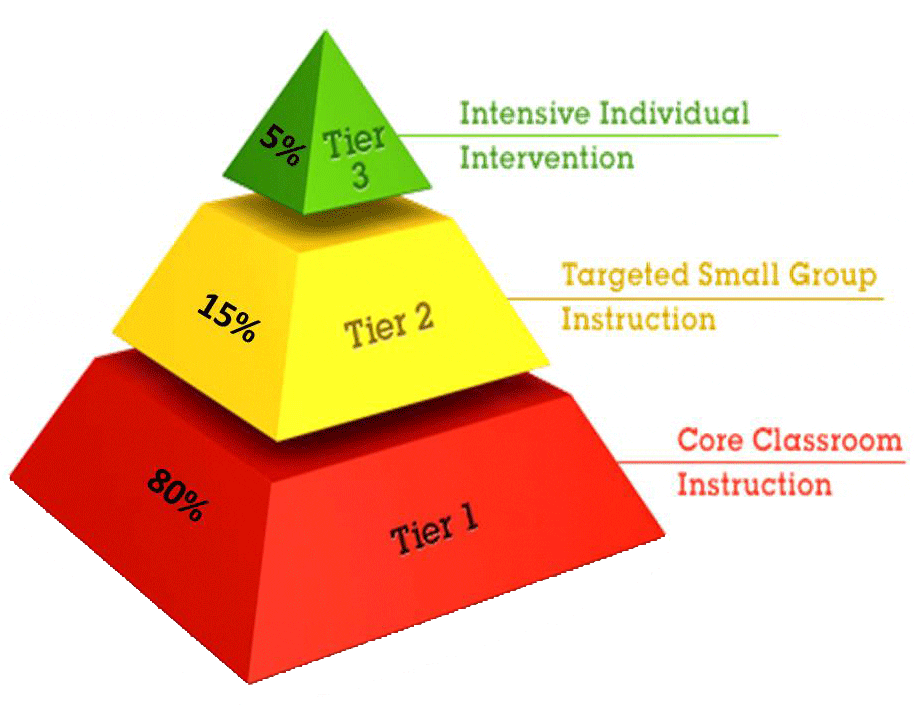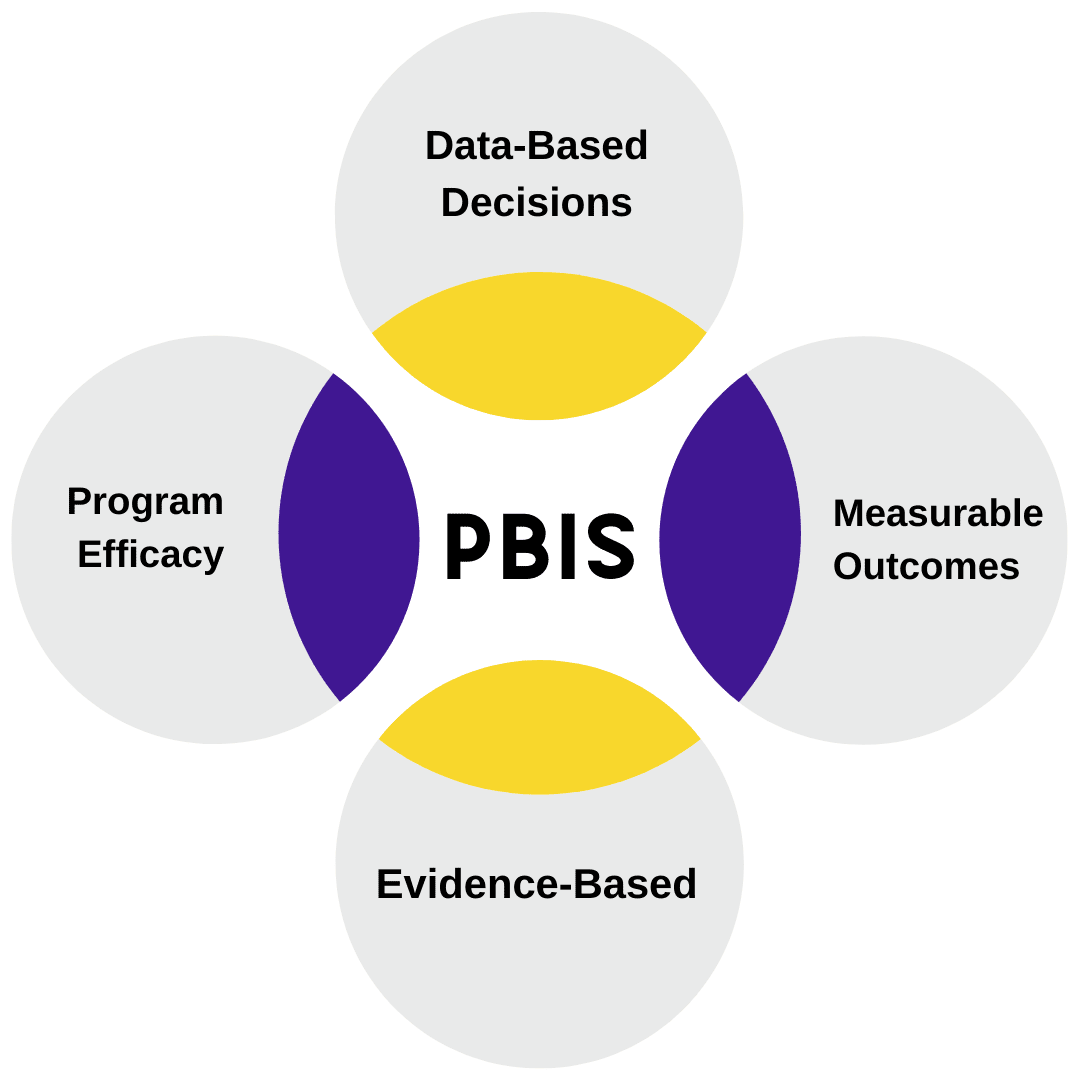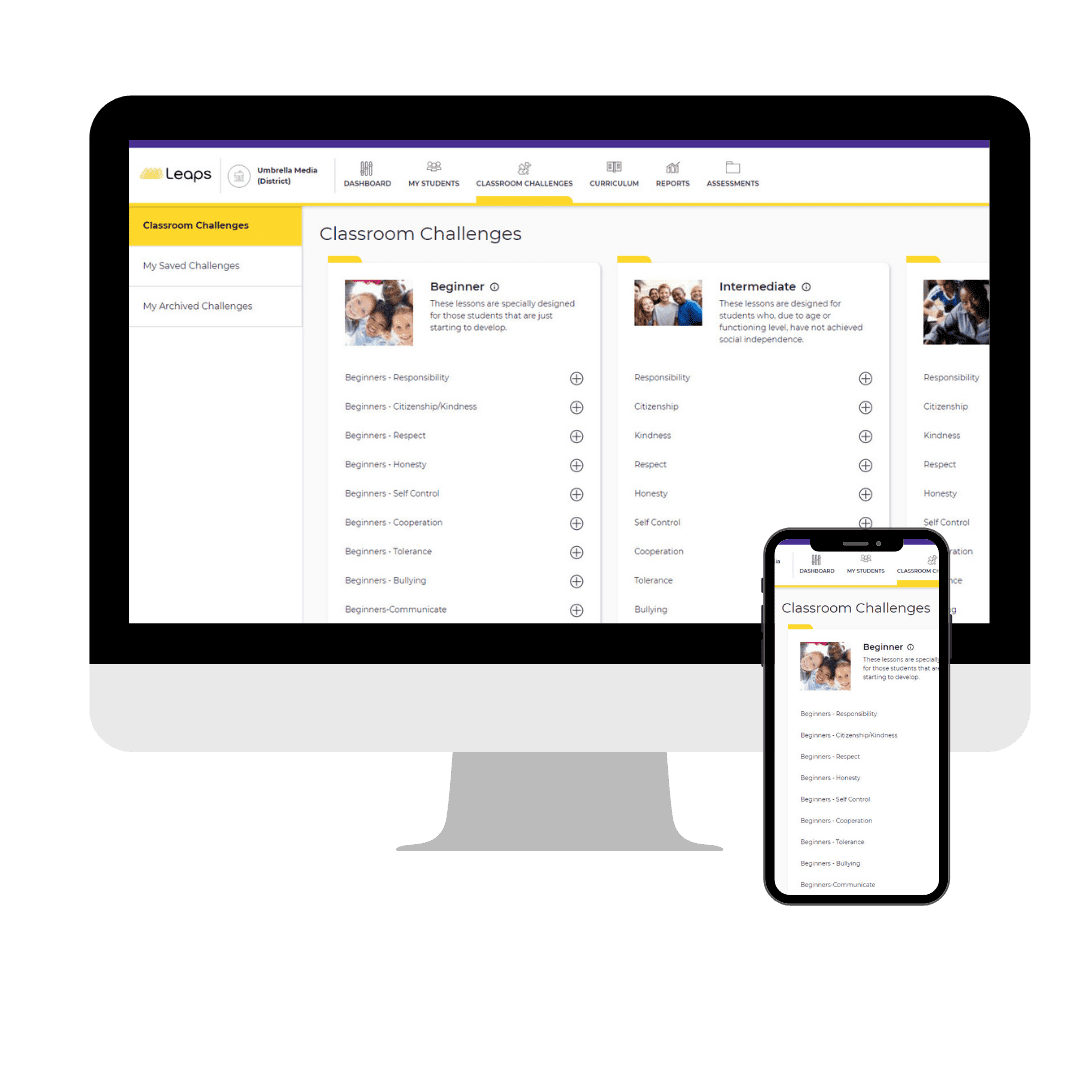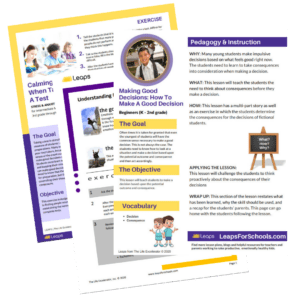Behavior Support
Leaps provides all the necessary content, curriculum, benchmarks, and progress reporting to help teachers implement positive behavioral change in the classroom.
How Leaps works with Behavior RTI and PBIS

Leaps provides the content, benchmarks & progress reporting for the positive behavioral components of RTI.
- Assessment tools
- Progress and regression notations
- Multi-tiered benchmarks
- Fidelity of Implementation reports based on usage, results and satisfaction
- Reporting at the individual student level or at the classroom, program, school or the entire district level
PBIS is a tremendous framework from which administrators and educators make decisions regarding the social, emotional and behavioral development of their students.
- Leaps operationalizes PBIS initiatives
- Leaps provides the content, assessments, progress, fidelity data and training that moves schools from a “framework” to an “operational environment”
Leaps Makes PBIS Practical
Leaps can help you achieve positive, pro-social behavioral goals by providing the processes and structure for implementing behavioral practices. Delivered through secure, online access, Leaps is highly portable and flexible for educators in classrooms, small groups, and one-on-one settings.
Leaps combines a robust library of content with a multi-modal assessing arm with automated fidelity and progress reporting with a proven training package that addresses implementation as well as longitudinal usage. This gives administrators the ability to create core elements of focus for the district or school while giving the educators the ability to address those elements within classrooms, small groups, and/or one-on-one settings. Educators can accomplish this common vision, language, experience and focus while still addressing the needs of their individual students.

Leaps & PBIS
PBIS and Leaps Overview
Leaps complements PBIS within four key elements of the PBIS framework. It is a comprehensive, online program and resource for educators who are creating learning environments built upon resources that provide both evidence of benefit and content for delivery.
1. Data for Decision Making
Leaps assessing processes, for individual students as well as small groups and classrooms, provides the information educators need to determine the level of behavioral service a student should receive and provides the actual fulfillment of service resource within the assigned level.
2. Measurable Outcomes
Leaps assessing processes are automated and collected electronically which provides the opportunity to reassess post-participation. Leaps provides the ability to compare the pre and post participation reports. This data driven reporting process quantifies levels of functioning within key behavioral realms and then compares functioning levels across time to denote actual progress.
3. Evidence Based Content for Outcomes
Leaps provides full lesson planning for all areas of assessed need. These lesson plans are the content fulfillment process that has been vetted and is fully evidence based to create positive and pro-social behavioral changes.
4. Implementation Practices
Leaps offers a comprehensive and proven implementation package that includes usage based training, administrative training and ongoing topical training for the expansion of behavioral services within general education. Trainings are supplemented by ongoing fidelity reporting based on use of, satisfaction with, and saturation levels of programming. This data reporting process is then combined with automated progress reporting to determine the areas where progress is being achieved and the resources that were used to attain the progress.
PBIS Tier 1 Initiatives
I. Primary Prevention: System and Classroom Leaps provides a broad array of social and emotional development content in both higher and lower maturity lesson formats. In fact, Leaps offers nearly 200 lesson plans covering the range of social development topics from basic living, to communication and decision making, to clinical skills. With thousands of pages of lesson plans, worksheets and family communication recaps – how does an educator know what to do?
Leaps has the answer: through a classroom based observational assessment process that identifies the most relevant lesson plans for a classroom based upon the observations of the teacher. This allows for a systemic focus on a core element such as Bullying or Respect but it also means that each individual classroom, though focused on the core element, is learning skills necessary for that class.
There are commonalities within the core elements of social and emotional growth but the fulfillment of those developmental processes would be based upon educator input that allows for an individualization of teaching for that classroom. The Leaps Classroom Challenges resource accomplishes this. The system sets the focus, the teacher gives his or her input, Leaps assigns the lessons, and the students learn the social and emotional elements within a framework of their need.
PBIS Tier 2 Initiatives
II. Secondary Prevention: Specialized Small Group
Leaps has a multi-modal, multi-tiered assessing process. This process allows for the individual assessment of a student. Leaps takes this assessment and creates an automated profile of the student that quantifies the student’s current psychosocial functioning level and then correlates the risk of behaviors to this functioning level. Leaps then breaks this functioning level into 10 categories and quantifies the student’s strengths and deficits within each category and provides the data necessary to identify the students whose categorical functioning levels indicate placement in specific small groups. Finally, the Leaps profile provides a formulary based prescription of what to teach for intervention, prevention, and social support purposes.
For small groups, Leaps enables educators to choose completed, individual profiles of the specific students he or she wants in a small group from the database. Leaps then takes each individual student’s profile and aggregates them into a profile for the small group. Leaps takes this data and creates a report on the group that outlines the functioning level of the group, the categorical strengths and deficits of the group, and then provides a prescription for intervention, prevention, and social support lessons specific to the needs of the students within that group. Leaps then fulfills all areas of need with content in the form of lesson plans that are specifically designed for the areas of need of the small group.
Finally, Leaps provides a comparison tool that gives the educator the ability to compare the group’s functioning levels, within the categories measured, at the pre-participation level to the groups post-participation level of functioning. Leaps actually quantifies the groups levels of functioning with each of the 10 measured categories and automates the progress reporting for the group by comparing pre and post participation functioning levels and reporting on quantified progress and the percentage of progress this represents. Leaps gives the educator everything he or she needs to identify the students in need of a small group, identify the small groups he or she needs to create, align the students into the correct group, access the content necessary for that specific group, and then report the groups progress as well as the progress of individual group participants.
Leaps & RTI
RTI Tier 1 Initiatives
Leaps is a comprehensive social and emotional interactive curriculum replete with multi-modal assessing instruments. Leaps Classroom Challenges is a perfect fit for the process of utilizing prescriptive assessments to design instruction. This feature allows classroom teachers to identify the area of topical focus based upon the preventative needs presented by the classroom.
Using the Leaps Classroom Challenges tool, classroom educators simply choose the area of focused preventative training or need for their class and then answer simple behavioral observational questions. These focused areas cover a range of categorical needs from citizenship to respect to bullying and 6 other categorical values and character traits. Based upon the observations of the educator, Leaps will identify the most relevant lesson plans for that class as well as the necessary secondary support lessons.
Because the Classroom Challenges tool is designed to elicit an observational response from the educator, Leaps can identify the areas of need that are most relevant to the class even from a preventative format. This greatly increases efficiency and effectiveness of the time allotted for Tier I Prevention. This process also affords teacher input which increases the likelihood of teacher buy-in and participation.
Finally, the Classroom Challenges report is printable. When printed the report serves as the benchmark reporting for Tier I because areas of primary and secondary need, from a preventative standpoint, are identified and then those areas of need are supported through lesson plan delivery for both primary and secondary levels. This process removes the guesswork, makes the process relevant to that specific class, affords the opportunity for a systemic, or school-wide focus on a given area while still focusing on the individual needs of that particular class, and helps brings the teachers input into the solution.
RTI Tier 2 Initiatives
Leaps provides the assessing and reporting tools to identify the students in need of behavioral intervention training as well as the data necessary to create and assign small group placement for maximum benefit of results. Leaps accomplishes this by identifying the individual needs of students but then reporting those individual needs in a categorical fashion for small group development. This specificity gives the educator/interventionist the best opportunity to group students based upon real need and therefore the best opportunity to intervene in that need while producing measurable and demonstrable benchmarks for placement, progress, and exiting the group. Leaps produces Tier II reporting and programming results by:
- identifying behaviorally at-risk students through a robust multi-modal assessing process
- creating an individualized student plan that identifies the students individual level of functioning but comports those individual needs into group modality formats
- identifying areas of need that are common amongst different students for the development of small groups
- Providing the reportable benchmarks with a parental interpretation for an active communication plan
- creating categorical benchmarks for pre and post participation measurements
- categorizing areas of intervention into functional groupings which makes communication, implementation, and fidelity efficient and effective
- On average, 15% of a school’s students are identified as at-risk, performing below expected levels, or needing specific supports to make adequate academic progress. Leaps resources, in the form of individual and group assessment tools, enable educators to precisely target the skill deficits that can best help the student function, cope and adapt more appropriately to his school, community, and home environments. This gives the student the best opportunity for academic success. Leaps lesson plans are designed to foster active discussion and role-play scenarios that are ideal for small group or classroom use.
- Most Tier II Leaps implementations are centered around grouping students into categorical, or functional groups, based upon a commonality of assessed deficits. This specificity of grouping process allows for a true entrance criteria, progress goals, and measurable and reportable outcomes.
RTI Tier 3 Initiatives
Leaps provides a multi-modal, multiple format assessing process that creates a highly individualized behavior improvement plan. This plan denotes the level of functioning of the student and the associated risk, it then categorizes and reports skills strengths and deficits, and then it identifies the intervention, prevention, and social integration areas of need. Leaps then fills each of these areas of need with lesson plans for intervention, prevention, and remediation. This process provides the opportunity for a pre and post participation assessment which provides specific and quantifiable statements of progress or regression. Leaps assessing and student profiling:
- identifies the specific level of functioning of the student and then denotes the functional and behavioral risks associated with this level of functioning
- communicates the areas of strength and deficit and then provides an interpretation of the areas of need and their potential impact
- provides a categorical breakdown of areas of need with specific levels of functioning within each of the existing categories. This information allows for a small group development and placement based upon a specificity of need
- creates an evolving improvement plan based upon the progress or decompensation of the student and then identifies the specific areas of need to be addressed in a priority order. Specific remediation content is then provided for each area of assigned need

Whitepaper: Leaps & PBIS for Behavior
Whitepaper: Leaps & RTI for Behavior
More About Our Tools
On Mental Health
Leaps was developed with more than twenty five years of research and real world application with mental health and education as the essential tools for teachers to help students grow and learn
Social Emotional Learning
Leaps takes the broad concepts of social and emotional learning and brings a practical program to the table with very specific, easily identifiable skills.



 Â
Â